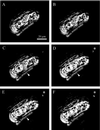Digital in-line holography for biological applications
- PMID: 11572982
- PMCID: PMC58724
- DOI: 10.1073/pnas.191361398
Digital in-line holography for biological applications
Abstract
Digital in-line holography with numerical reconstruction has been developed into a new tool, specifically for biological applications, that routinely achieves both lateral and depth resolution, at least at the micron level, in three-dimensional imaging. The experimental and numerical procedures have been incorporated into a program package with a very fast reconstruction algorithm that is now capable of real-time reconstruction. This capability is demonstrated for diverse objects, such as suspension of microspheres and biological samples (diatom, the head of Drosophila melanogaster), and the advantages are discussed by comparing holographic reconstructions with images taken by using conventional compound light microscopy.
Figures





References
-
- Gabor D. Nature (London) 1948;161:777–778. - PubMed
-
- Leith E N, Upatnieks J. J Opt Soc Am. 1962;52:1123–1130.
-
- Leith E N, Upatnieks J. J Opt Soc Am. 1963;53:1377.
-
- Leith E N, Upatnieks J. J Opt Soc Am. 1964;54:1295–1301.
-
- Kreis T. Holographic Interferometry. Berlin: Akademie; 1996.
Publication types
MeSH terms
Substances
LinkOut - more resources
Full Text Sources
Other Literature Sources
Molecular Biology Databases

